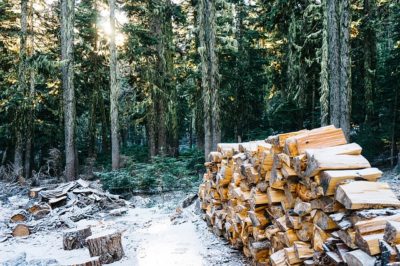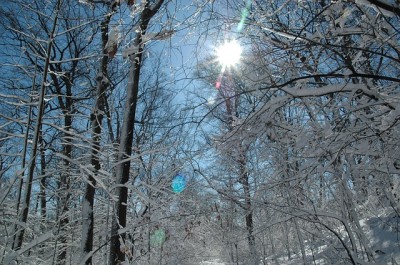 Winter months present a unique challenge in many parts of North America due to freezing temperatures. In fact, no other season is as deadly if the electricity goes out. So how do you prepare to survive the cold season? What should you stockpile? And if you’re tied to the electric grid, what do you do if the power goes out?
Winter months present a unique challenge in many parts of North America due to freezing temperatures. In fact, no other season is as deadly if the electricity goes out. So how do you prepare to survive the cold season? What should you stockpile? And if you’re tied to the electric grid, what do you do if the power goes out?
Heat is the Key
If there is no electric power you can always assume you’ll have gas. But many gas appliances from furnaces and water heaters to gas ranges have electric components. They also have compressors that are electric powered to force the air through your home. You could always light a gas range cook top with a match or flame, but don’t assume for a minute it can serve as a heat source unless you’re absolutely desperate. You can put some cast iron over the gas range cook top to act as a heat conductor after you have switched off the gas, but it’s not going to add much heat to you home.
If you have a fireplace, it can certainly help you stay warm. But be forewarned. Ninety percent of your heat is going up the chimney with the smoke. A fireplace will heat a room, maybe two. It will not heat a whole house. You can close-off sections of your house, but you’ll discover very quickly that a fireplace is a highly localized and inefficient heat source.
Heating Solutions
Buy a small cast-iron stove that you can quickly install into your fireplace. You’ll have to attach a stove pipe that exhausts up the flue, and some heavy duty aluminum foil affixed with foil tape to seal off the flue. Once you’ve done that, your cast iron stove will be a heat exchanger that will add significantly more heat than a traditional fire in a fireplace.
You could also have a wood-burning stove installed in your home to not only supplement your heating while on-the-grid, but to serve in an emergency off-the-grid.
Keep in mind that just because you have an efficient word-burning stove it doesn’t mean it will heat your entire home. It’s all a question of square footage and the design of your home, as well as the size and number of wood-burning stoves inside. While some people have installed “whole-house” wood-burning solutions, most people have just one wood-burning alternative.
Keeping a two-story home warm is the most challenging. Heat rises and cold descends. If the temperature outside is zero degrees, your house will quickly equalize to that temperature. A single, wood burning stove in the fireplace will not efficiently heat a two-story home. The temperature will rise, but you’ll be lucky to have an average temperature above freezing across your home.
The Most Versatile Backup Stove In The World Allows You To Cook Anything, Any Time, Any Where
As a result, you may have to rethink your living and sleeping arrangements during a particularly cold weather. Your first step is to abandon the second story. Close all of the doors upstairs and try to block off any hallways with a sheet that is tightly suspended or tacked around the wood framing to the hallway. You also might want to consider closing off rooms that are not critical, like a formal dining room.
A Special Note About Kerosene Heaters
Kerosene heaters give off significant amounts of carbon monoxide. You could always place one in the fireplace in place of a wood-burning fire, but unless you close off the flue to some degree and carefully vent the kerosene heater you’ll lose more heat up the flue than you generate.
Putting a kerosene heater in proximity to a fireplace could also encourage venting of the carbon monoxide. But manage it carefully and if you feel dizzy, nauseous or have a headache, know that you may be succumbing to carbon monoxide poisoning. If you have children, they will be affected more quickly due to being smaller.
Avoiding Frozen Pipes
If you cut off heat to the second floor of your home for any length of time, you’ll want to drain the water from sinks, toilets, showers and bath tubs throughout the house. Without electricity you probably won’t have running water and will be depending on local water supplies, your stockpile of water, or melted snow and ice.
You can still flush a toilet without running water. You just have to fill the toilet tank with sufficient water to effectively flush. This is a good argument for keeping a constant supply of melted snow or ice on hand in a large 5-gallon bucket or two.
Cooking Off-The-Grid
Without electricity you’ll find cooking to be a continuing challenge especially in winter. There’s a remote possibility that a gas range may function, but you’ll need to light the flame manually.
You also can cook in your fireplace or on the surface of a wood burning stove. Make sure you have an ample supply of cast-iron cookware on hand including covered pots like a Dutch Oven. Some people use a corner of the fireplace for cooking with a metal grate to support a pot or pan.
You also have the option of cooking over an open fire in the backyard or a kettle grill stocked with wood that has burned down to coals that are manageable for cooking. This is a cold proposition depending on outside temps, but if you have a covered grill you can hurry inside while the food is cooking outside. Here again, consider the cooking equipment you might need to cook a variety of dishes and meal types outside.
Bedding and Clothing
It’s obvious that winter clothing makes sense in winter but there are some items you want to make sure you consider. One is sometimes referred to as a “night-cap” and no, it’s not an evening cocktail. If you’ve ever slept in a tent in the winter you know how cold your head can become. In fact, we lose 40 percent of our body heat through our heads. You might want to consider sleeping with hat on.
Bedding should be ample with extra blankets, quilts or sleeping bags. If you’re sleeping on the floor in a family room or on a couch, having extra blankets on hand can not only keep you warm, but accommodate friends and family that may have joined you because they don’t have a fireplace or wood-burning stove.
Lighting
In addition to the cold, it’s also darker in many parts of the world during winter. Candles are a primary consideration along with a few lanterns that burn a clean oil.
There are also flashlights that are cranked by hand to provide a light source without batteries. If you are going to depend on battery-powered flashlights to any degree, consider a solar recharger. Remember, however, sunny days in the winter are short and might be few and far between.
Laundry as a Humidifier
Laundry is a tough one in winter without electricity and ample supplies of water. Your primary focus should be on laundering socks and underwear and any other clothing that is obviously soiled.
These Solar Backup Generators Deliver 4 Times More Power Than Other Models!
A benefit of doing laundry in the house and hanging it to dry is the humidity that it creates. Just like on a hot summer day, the humidity will make you feel warmer. And if you are heating with wood you may find the laundry drying surprisingly fast due to the dryness of the air.
If you need humidity and the laundry is done, you can always use some dowels to support a towel in a 5-gallon plastic bucket filled with water. The towel should emerge above the water level to some degree and will act as a wick to add humidity to the air.
Creating a Winter Stockpile
If you want to prepare for a winter off-the-grid, you need to figure out some basics. One is the number of people you think you will be housing. This could go beyond your immediate family as extended family members seek shelter in a location with basic resources they may be lacking.
Here’s a checklist to serve as a reminder. It may vary depending on your circumstances and already assumes you have ample supplies of food and drinking water:
- A wood-burning stove with the necessary equipment to install it in a fireplace, including stove pipes, foil and foil tape, along with an ash bucket and ash shovel.
- Sufficient firewood to heat throughout the winter
- A kerosene heater if you can properly vent it. Make sure to have enough fuel, replacement wicks and filters to keep it operating.
- Lumbering tools for harvesting and stocking additional firewood.
- Cooking equipment and utensils for cooking on a wood stove, open fire or kettle grill.
- Sufficient candles, lanterns, lantern oil and flashlight options that are hand-powered or solar-powered, along with sufficient fire-starting materials like matches and lighters.
- Up to a dozen, 5-gallon plastic buckets for water collection of snow and ice and other needs.
- Sufficient winter clothing for you, your family and others who may join you.
- Sufficient bedding in the form of blankets, pillows, quilts and sleeping bags, plus sheets that also can be used to temporarily seal off hallways and stairways.
- Soap for washing and laundry.
- Rope to hang laundry to dry and act as a humidifying agent.
This list is by no means exhaustive, but it’s a good start. The key is to stop and anticipate your needs and do some estimates so you have enough on hand to get through winter and early spring.
Source:.offthegridnews.com


Leave a Reply